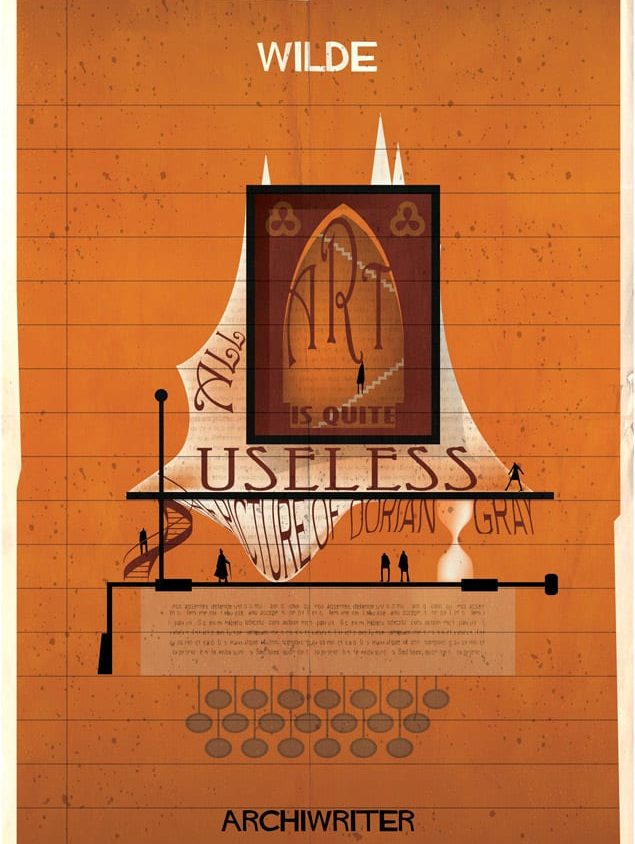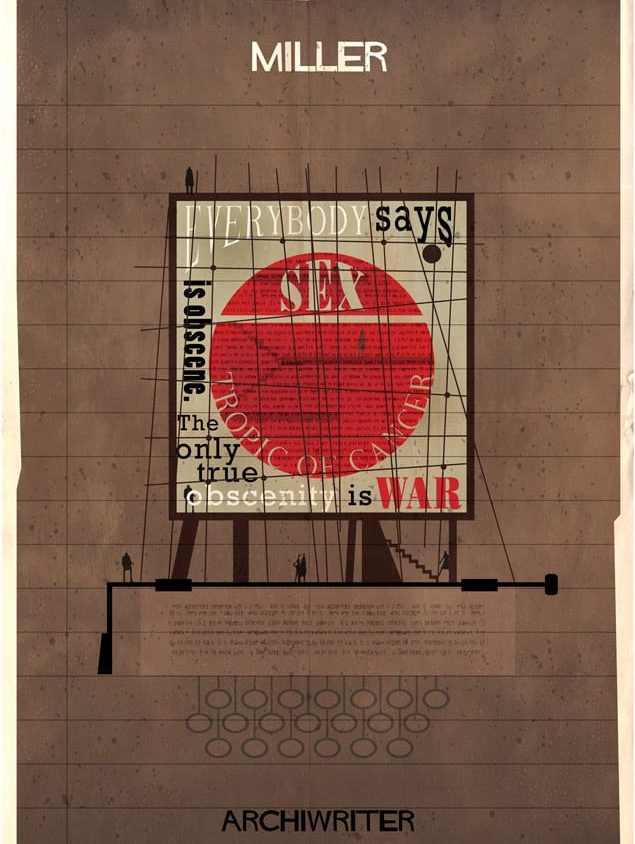Archiwriter
Los “retratos arquitectónicos” de Federico Babina.

Archiwriter es una serie de dibujos a través de los cuales Babina retrata a autores universales desde su estilo, épocas y lugares por los que atravesaron.
La arquitectura literaria de un texto
Archiwriter es una serie de 27 dibujos a través de los cuales Federico Babina retrata a autores universales a lo largo de sus historias, viajes y lugares.
Siguiendo las palabras de Ernest Hemingway “La prosa es la arquitectura, no la decoración de interiores”, Babina analiza la literatura como un espacio arquitectónico que se define por su estructura literaria, el estilo narrativo, el ritmo y la secuencia de palabras. Los detalles del lenguaje completan la obra, como la decoración en una casa.
«Inmerso en la lectura de un libro, me siento como estar dentro de una arquitectura, un espacio metafísico rodeado por palabras. Se puede caminar en ella lentamente, como de puntillas, sin hacer ruido para descubrir los espacios y sentirse más cómodo, incluso sentirse protegido como en casa”, explica Federico Babina al hablar sobre Archiwriter.
El resultado de sus obras puede resultar “fluctuante, vernáculo, itinerante, efímero, concéntrico, laberíntico, surrealista, onírico y futurista, pero el elemento común es tratar de escribir una arquitectura que ilustra una historia de la literatura».
The literary architecture of a text
In this series of 27 drawings I continue my illustrated journey of research, dialog, crossover, interposition. interlacement and weaving between different forms of expression.
A literature text is based on a thematic foundation is supports through a literary structure, is defined by a narrative style, is cased with the rhythm and the sequence of words and is decorated with the details of language. You can perceive a text page as a three‐dimensional structure where the solids and voids is holding up on a delicate spatial balance. It is possible to embark on a journey wrapped with imagination to be able to read between the sequence of words and discover the third dimensional level. The style of a text and the personality of a writer, the issues that he’s facing and the story that relates can become a small illustrated architecture read with fantasy. Immersed in reading a book it feels like inside an architecture, a metaphysical space surrounded by the words. You walk into it slowly, as on tiptoe, to discover quietly the spaces and be more comfortable with the perception of the areas up to feel protected,like at home. Every literary story has a specific structure is built and is elevates with its own chronology with a changing tension and wrapped in a skin made up of different tones , shades and opacity. The buildings that relate these stories are heterogeneous as the authors portrait. They could be fluctuating, vernacular, itinerant, ephemeral, concentric, labyrinthine, surrealist, oneiric and futuristic but the common element is to try to” write architecture illustrating a literary history”. Prose is architecture, not interior decoration. – Ernest Hemingway
- Fiódor Dostoyevski the philosophical polyphony
- Italo Calvino the exactitude of magination
- Franz Kafka the labyrinth of metaphors
- George Orwell the effective minimalism
- Jack Kerouac the improvisation journey
- Charles Bukowski the urban poetry
- Haruki Murakami the noisy loneliness
- Hermann Hesse the hagiographic mysticism
- Albert Camus the sense of isolation
- Milan Kundera the lightness of absence
- Federico García Lorca the power of metaphor
- León Tolstói the ascetic morality
- Paul Auster the layers of identity
- Ernest Hemingway the absence of lyrical
- Oscar Wilde the tears of hedonism
- William Shakespeare the medieval metaphor
- Raymond Carver the ordinary details
- William Burroughs the paranoid order
- Dante Alighieri the lyric travel
- John Fante the beauty of bitterness
- Truman Capote The fashionable nightmare
- Richard Wright the cage of race
- Gabriel Garcia Marquez the timeless isolation
- Henry Miller the sensuality of reality
- Isaac Asimov the hidden universe
- Marcel Proust the structure of memory
- James Joyce the stream of consciousness
Para comprar las obras: (society6.com/federicobabina)
Fuente: Federico Babina (federicobabina.com)
Imágenes cortesía de Federico Babina (federicobabina.com)
Sobre el autor






























 Sorprendentemente, este lugar funciona
Sorprendentemente, este lugar funciona Modelos de una ciudad futurista
Modelos de una ciudad futurista Las «Torres Flotantes» de Mohaded
Las «Torres Flotantes» de Mohaded Raytrace, la instalación de Layer
Raytrace, la instalación de Layer
